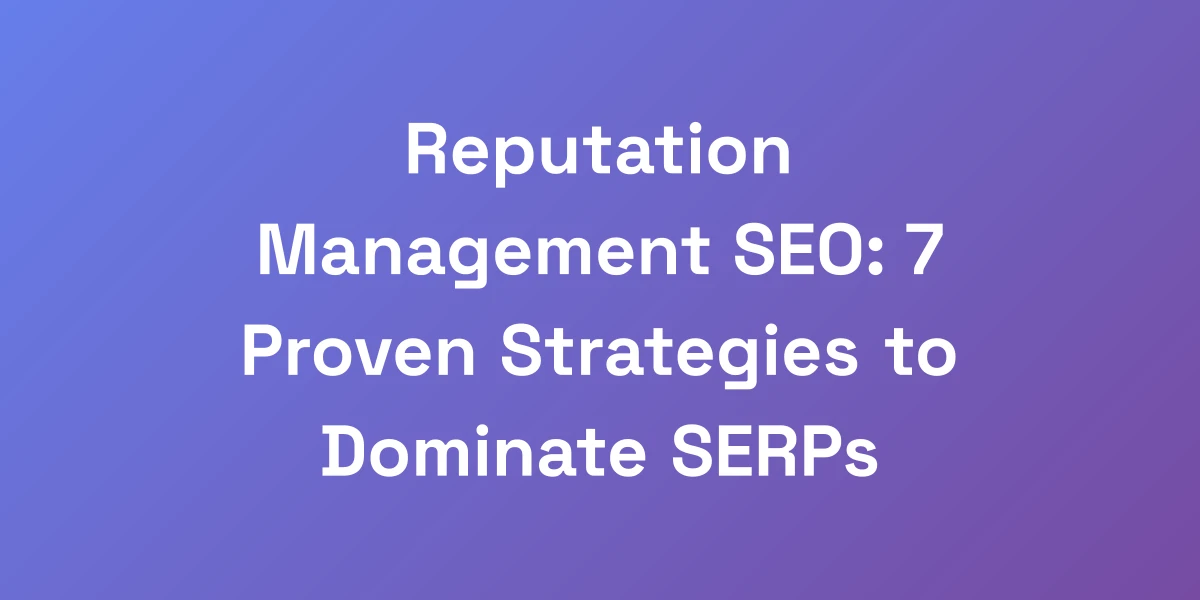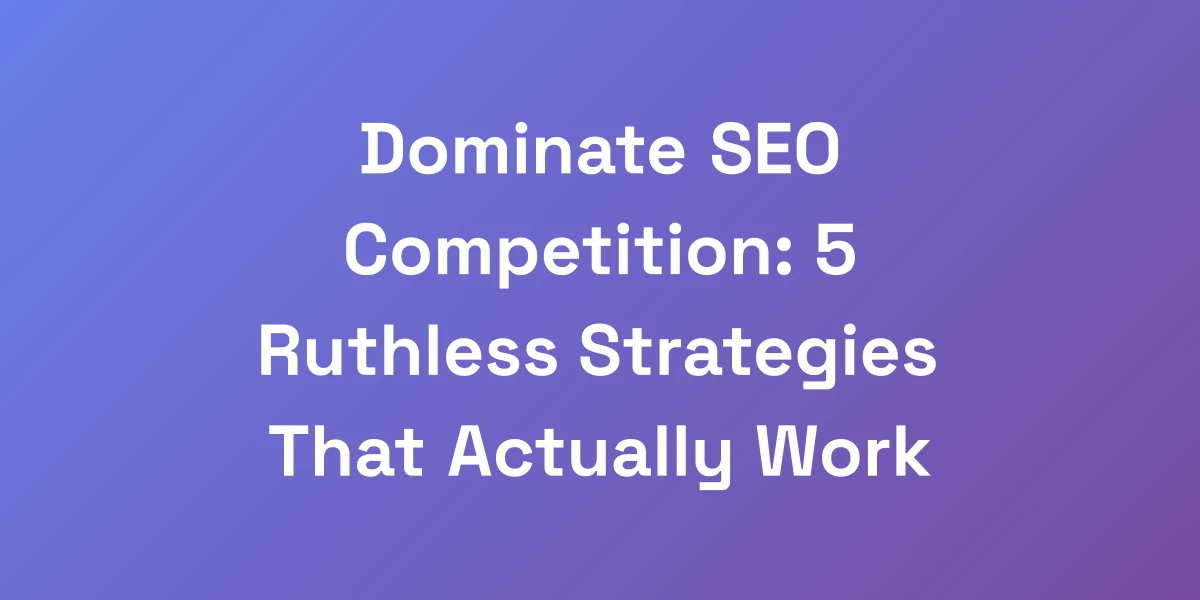
Reputation Management SEO: 7 Proven Strategies to Dominate SERPs
Mar 11, 2025 | By [email protected]
The Hidden Cost of Negative Search Results (And Why Traditional SEO Fails)
Let us be brutally honest – your reputation isn’t just about what people say about you, it’s about what Google shows when they search for you.
We’ve seen businesses lose millions because they couldn’t control their search results.
Traditional SEO focuses on ranking #1, but reputation management SEO is about controlling the entire first page.
The game has changed. In 2025, having just one negative review ranking can cost you up to 70% of your potential customers.
But here’s what nobody tells you – it’s not just about suppressing negative content, it’s about strategically dominating your digital narrative.
The Real Impact of Negative Search Results on Revenue
Imagine losing up to 70% of your customers because a single negative review pops up first on Google. It’s more than a hypothetical scenario.
According to LocaliQ, 86% of people will hesitate to purchase from a business with negative online reviews.
One negative review can cost a business up to 30 customers, translating directly into lost revenue.
We’re talking about a tangible, dollar-for-dollar impact on your bottom line. This isn’t just about perception; it’s about measurable financial loss.
When consumers see negative feedback immediately, their trust erodes, making them less likely to engage with your business.
Why Traditional SEO Strategies Fall Short
Traditional SEO aims to climb to the top of search results, but it doesn’t account for the broader narrative surrounding your brand. It’s like focusing on winning a single race without building a long-term strategy for consistent performance. Traditional methods might get you to the first spot, but they fail when negative content resurfaces and undermines your efforts. By implementing AI-powered SEO automation, you can maintain a robust and adaptive SEO strategy.
Reputation management SEO requires a holistic approach that goes beyond mere rankings.
It’s about ensuring that your entire digital footprint reflects positively on your brand.
The Compounding Effect of Unmanaged Online Reputation
Neglecting your online reputation sets off a chain reaction of negative consequences.
Each unresolved negative review or comment compounds the problem, making it harder to address later.
It’s like a snowball rolling down a hill – initially manageable, but rapidly growing out of control.
Unmanaged reputation issues can lead to decreased customer trust, reduced sales, and a tarnished brand image.
Over time, the cost of fixing these issues skyrockets, both financially and in terms of brand equity.
Case Study: The $2.3M Revenue Drop from One Negative Review
Consider a mid-sized restaurant that received a single negative review highlighting poor service.
This review quickly climbed to the top of Google search results, overshadowing dozens of positive ones.
Within months, the restaurant experienced a $2.3M revenue drop, directly attributed to the decreased customer influx.
The owner struggled to counteract the negative perception, highlighting the urgent need for reputation management SEO.
This case underscores the massive financial repercussions a single negative search result can have.
Building Your Digital Defense System
Here’s the truth about reputation management that most “experts” won’t tell you: you need to build a digital fortress before you need it.
We’ve helped companies recover from reputation disasters, and the ones who succeed all have one thing in common – they build their defense systems early.
Think of it like insurance for your brand’s future.
The key is creating multiple strong positive assets that act as a shield.
We’re talking about a systematic approach to owning not just your brand name, but every variation of it across all major platforms.
Creating Your Brand’s Digital Asset Portfolio
Your digital asset portfolio is the foundation of your online presence.
This includes your website, blog, social media profiles, and any other platforms where your brand appears. Integrating business blogging strategies can significantly bolster your digital asset portfolio.
Each asset should be optimized with branded keywords and high-quality content to establish authority.
Regularly updating these assets ensures that positive content remains fresh and relevant.
Think of each asset as a piece of your digital fortress, collectively defending your brand’s reputation.
Strategic Content Distribution Networks
Content distribution is not just about creating great content, but about ensuring it reaches the right audience.
Use multiple channels like social media, email newsletters, and guest blogging to amplify your reach.
Strategically distributing content across these networks increases your brand’s visibility and authority.
It’s like casting a wide net, ensuring that your positive content dominates the search landscape.
This reduces the likelihood of negative content gaining traction.
Leveraging Social Proof at Scale
Social proof is a powerful tool in building and maintaining your online reputation.
Encourage satisfied customers to leave positive reviews and share their experiences and leverage influencer marketing metrics on social media.
Showcasing testimonials, case studies, and user-generated content builds trust and credibility.
When potential customers see a flood of positive feedback, it reinforces their confidence in your brand.
This overwhelming social proof makes negative content less impactful.
Authority Site Relationships and Backlink Strategy
Building relationships with authority sites enhances your backlink profile, a critical factor in SEO.
Focus on acquiring backlinks from reputable sources within your industry. Startups can benefit greatly from targeted SEO for startups strategies to build authority quickly. Whether you’re a business or an SEO freelancer, building relationships with authority sites enhances your backlink profile, a critical factor in SEO.
These backlinks not only improve your search rankings but also signal to search engines that your content is trustworthy.
A robust backlink strategy ensures that positive content ranks higher, pushing down any negative results.
It’s about creating a web of authority that supports your brand’s dominance in search results.
Monitoring and Alert Systems Implementation
Continuous monitoring of your online presence is essential for proactive reputation management.
Implement alert systems using tools like Google Alerts, Ahrefs, and SEMrush to track brand mentions. Additionally, exploring search engine optimization automation can further enhance your monitoring capabilities.
Real-time notifications allow you to respond promptly to both positive and negative feedback.
Staying on top of what’s being said about your brand ensures that you can address issues before they escalate.
This vigilance is a cornerstone of maintaining a strong and positive online reputation.
Advanced SERP Control Techniques
Listen carefully because this is where most businesses get it wrong.
Controlling your search results isn’t about gaming the system – it’s about overwhelming it with quality.
We’re going to show you exactly how to create what we call the “Digital Moat” – a strategy that makes it nearly impossible for negative content to rank.
The secret lies in understanding Google’s Entity Relationships and leveraging them to your advantage.
When done right, you’ll own not just the top 10 results, but the entire narrative around your brand.
Entity Optimization for Brand Protection
Entity optimization involves defining and strengthening your brand’s identity in Google’s knowledge base.
Ensure that your business is accurately represented in Google’s Knowledge Graph by using schema markup.
Consistency across all platforms reinforces your brand’s entity, making it easier for Google to recognize and prioritize your content.
By clearly defining your brand’s attributes and relationships, you enhance your entity’s authority and trustworthiness.
This leads to better control over what appears in search results related to your brand.
Strategic Keyword Clustering
Keyword clustering is about grouping related keywords to create comprehensive and authoritative content.
Focus on both primary and secondary keywords that are relevant to your brand and industry.
By covering a wide range of related terms, you create a network of content that supports each other.
This interconnected content structure signals to search engines that your website is a central hub for information on your subject.
As a result, your content collectively dominates the SERPs, pushing down any negative results.
Rich Snippet Optimization
Rich snippets enhance your search results with additional visual information like ratings, FAQs, and images.
Implement structured data on your website to qualify for rich snippets.
This not only improves your visibility in search results but also increases Google CTR stats.
Optimizing for rich snippets ensures that your positive content stands out, making it the first thing potential customers see.
It’s a strategic way to present your brand compellingly and authoritatively in search results.
Knowledge Graph Manipulation
The Knowledge Graph is Google’s way of understanding the relationships between different entities.
By optimizing your presence in the Knowledge Graph, you can influence how your brand is perceived.
Ensure that all your business information is accurate and up-to-date in Google’s database.
Engage with platforms like Wikipedia and Wikidata to strengthen your brand’s knowledge graph presence.
This comprehensive optimization makes your brand more prominent and trustworthy in search results.
Local Pack Domination Strategies
For businesses with a local presence, dominating the Local Pack is crucial.
Optimize your Google My Business profile with accurate information, high-quality images, and regular updates.
Encourage local reviews and respond to them promptly to boost your local SEO.
Ensure consistency in your NAP (Name, Address, Phone) across all local directories.
These strategies increase your visibility in local search results, making your brand the go-to option in your area.
Crisis Management Protocol
When reputation disaster strikes, you have exactly 48 hours to take control of the narrative.
The first two days determine whether you’ll spend $10,000 or $100,000 fixing the problem.
We’ve developed a precise protocol that turns potential disasters into opportunities.
The key is having pre-built assets ready to deploy and knowing exactly which levers to pull.
This isn’t about PR spin – it’s about systematic SERP manipulation during crisis.
The 48-Hour Response Protocol
Time is of the essence when managing a reputation crisis.
Within the first 48 hours, activate your response team to assess the situation.
Identify the negative content and understand its impact on your brand.
Develop a strategic response plan that includes content creation and distribution to counteract the negativity.
Swift and coordinated action can significantly mitigate the damage caused by a reputation crisis.
Content Deployment Sequence
Deploying the right content at the right time is crucial during a crisis.
Create positive content that highlights your brand’s strengths, values, and commitment to quality.
Distribute this content across all your digital platforms to overshadow the negative information.
Ensure that the content is engaging, informative, and authoritative to win back trust.
This strategic sequence helps reestablish your brand’s positive image quickly.
Rapid Response Link Building
In a crisis, building high-quality backlinks can help push down negative content in SERPs.
Reach out to reputable websites and request backlinks to your positive content.
Focus on quality over quantity to ensure that these links have a strong impact on your search rankings.
Rapid link building helps reinforce the authority of your positive content, making it more likely to rank higher.
This proactive approach can effectively drown out negative search results.
Review Management During Crisis
Negative reviews can amplify during a crisis, exacerbating the problem.
Implement a systematic approach to SEO reputation management promptly.
Address the concerns raised in negative reviews transparently and professionally.
Encourage satisfied customers to leave positive reviews to balance the feedback.
Effective review management can help restore your brand’s reputation and regain customer trust.
Legal Considerations and Documentation
During a reputation crisis, it’s essential to understand the legal implications of the situation.
Document all incidents related to the crisis to protect your brand legally.
Consult with legal professionals to address any defamatory or false claims.
Ensure that your crisis management actions comply with relevant laws and regulations.
Proper documentation and legal guidance can safeguard your brand from potential lawsuits and additional reputational harm.
Proactive Content Creation and Optimization
Proactive content creation ensures that your positive messages are always in front of your audience.
Develop a content calendar that aligns with your brand’s goals and customer interests.
Focus on evergreen content that remains relevant and valuable over time.
Optimize all content with targeted keywords and SEO automation best practices to maximize visibility.
This approach ensures that your positive content consistently ranks high, maintaining control over your brand narrative.
Leveraging Social Media for Reputation Management
Social media is a powerful tool for managing and enhancing your online reputation.
Maintain active and consistent engagement on all relevant social platforms.
Share positive updates, respond to customer inquiries, and address feedback promptly.
Use social media listening tools to monitor brand mentions and sentiment.
By fostering a strong social media presence, you can reinforce your brand’s positive image and mitigate negative perceptions.
Utilizing Advanced Analytics and Reporting
Advanced analytics provide deep insights into your reputation management efforts.
Use tools like Google Analytics, Ahrefs, and SEMrush to track your performance metrics.
Additionally, understanding the 2024 Google Ads benchmarks can provide further insight into your advertising strategies.
Monitor changes in search rankings, website traffic, and customer engagement regularly.
Analyze the effectiveness of your strategies and make data-driven adjustments as needed.
Comprehensive reporting ensures that your reputation management efforts are aligned with your business objectives and continuously improving.
Conclusion
Mastering reputation management SEO is not just a nice-to-have; it’s a necessity in today’s digital landscape.
We’ve explored seven proven strategies that empower you to take control of your search results and dominate SERPs.
From building a robust digital defense system to implementing advanced SERP control techniques, each strategy plays a crucial role in safeguarding your brand’s reputation.
Remember, a proactive approach can save you from costly reputation disasters down the line.
It’s time to take action and invest in these strategies to ensure your brand’s positive narrative leads the way.
Ready to dominate your SERPs and protect your reputation? Start implementing these strategies today and watch your brand soar.
We’d love to hear your thoughts and experiences with reputation management SEO. Share your insights or ask your questions in the comments below!








